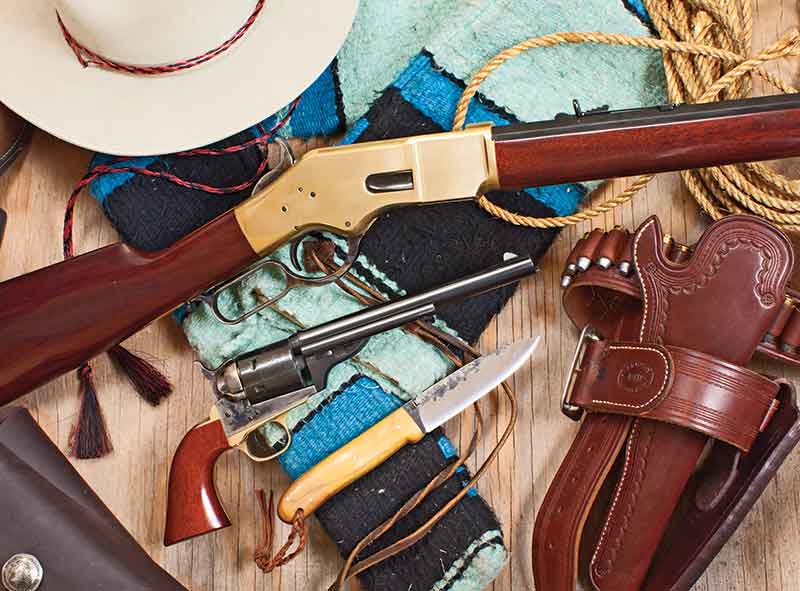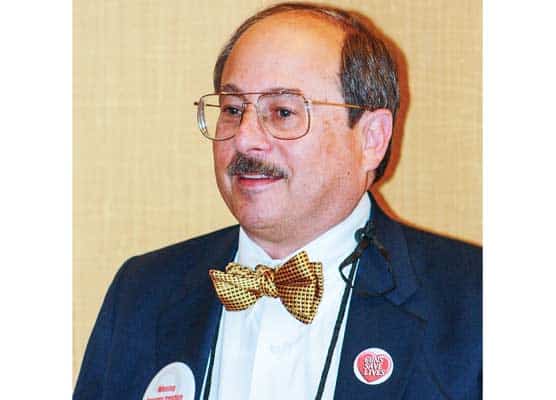First Pair
The Winchester 1866 Rifle And Colt 1872
Open Top Made An Admirable Duo,
But No One Knew Back Then!
Handgun/rifle combos were once a very important concept—and are still valid today—allowing simple interchangeability of ammo between dissimilar arms. While this first “pairing” fizzled originally, two of the very first guns sharing cartridges are replicated today in Cimarron’s 1866 Yellowboy and 1872 Open Top both in the modern calibers of .38 Special, .45 Colt and—our test subject—a .44 Special.
Cimarron’s 1866 rifle replicates the last version once available, which sold alongside the wildly popular and more versatile 1873 for decades. Visually, the most obvious change between early and late model 1866 rifles is the rear sight as used on the 1873—a buckhorn style sitting farther up the barrel—rather than the quaint, hard-to-use Civil War-era Henry style of the early 1866 rifles.
The notch in this later rear sight is wide and deep, giving a fast sight picture. For my eyes, it is a little too wide for precise shooting, but excellent for speed shooting paired with the square post front. While I believe I could shoot tighter groups were the notch smaller, it was quite easy to quickly roll soda cans at 30 yards. The curved rifle buttplate kept the rifle anchored to my shoulder as I worked the lever.
The hammer and lever are very nicely case colored, and many of the screws are a brilliant heat blue. The bright blue screws are beautiful against the brass. The brass receiver is soft and scratches easily. If you’re obsessed with keeping guns pristine, an 1866 is likely not for you, but I find the rifle gets more attractive as the finish ages and begins to show wear. Overall fit and finish of this 1866 was up to Cimarron’s high standards.
One extra advantage these brass actions offer is smoothness. All the ones I’ve tried have a better feel out-of-the-box than the steel-framed 1873 and this one was no exception.
The only safety present is the half-cock notch on the hammer, so it should be carried with an empty chamber. If, for some reason, you lower the hammer on a loaded round, be sure the hammer rests in the notch. The hammer should never be allowed to rest on the breechpin when the chamber is loaded.
One initial fly in the ointment was sight problems. I thought I had a nice group going when the gun suddenly shot 12 inches to the right. Ended my day right there.
Once back home I tried to move the rear sight first. Unable to budge the tiny rear sight set screw even though I ground a Brownells screwdriver bit to fit (the firm makes a nifty grinding wheel just for this purpose), I wound up damaging it. Disappointed, I moved on to see what sort of disaster I could perpetrate on the front sight. The front sight set screw loosened easily, and the sight fell out of the dovetail. At least the problem was obvious! I upended the sight and raised a lot of little divots on the base with a prick punch. Now it went in with a little effort and the setscrew locked it down. Wasn’t good enough, and Day 2 at the range also ended early. Now it was time to get tougher, so I dimpled the barrel dovetail, too, and the sight held, and has held through a little more than 100 rounds.

A funny thing (funny peculiar, not funny ha-ha) about this 1866 was the ejection pattern. If Jeff kept his face
on the stock, the cases launched a good foot in the air (above). If he lifted his head off the stock, the cases
dribbled up and out (below). They all came out, mind you, and no malfunctions occurred during feeding or cycling.
Just one of those odd things he hadn’t noticed with other rifles. But he’s not altogether sure what conclusion to
draw from it either. Photos: Roger Renner
Shooting The Yellowboy
The trouble with choosing the .44 Special is it’s never been offered in “rifle” ammo configuration, and factory ammo has widely disparate overall lengths. Cartridge OAL is of prime importance for this type of rifle, since the OAL doubles as the cartridge stop for the carrier/lifter to rise. Factory “Cowboy” ammo with 200-grain bullets, most popular in those loads, are too short to feed. Factory roundnose ammo is out because the cartridge nose is resting on the primer of the round ahead of it. Factory ammo (and my handloads) with semi-wadcutter “Keith-style” bullets wouldn’t feed worth a lick due to the bullet’s sharp shoulder.
Handloaders need be wary, too. My Lyman 49th Edition lists maximum OAL for the .44 Special as 1.615 inches. The window in which the carrier rises in the 1866’s receiver is only 1.610. There is some wiggle room in the overall length, though. My handloads at 1.485 inches function with no problems, as do factory loads as long as 1.580 inches.
When the rifle arrived, little did I know how wide and deep ObamaScare had dried up component availability. I had brass, powder and primers, but a lack of suitable bullets stalled me. Molds were unavailable, and commercial cast bullets were out thanks to long backorders.
So I started with what I had. A problem arose when the crimping groove proved too high on 200-grain bullets designed to work in the .44-40. Seating out the bullet for the correct overall length, I used a Lee .44 Special Factory Crimp Die to put a heavy taper crimp on the round. As a test, I loaded the rifle to capacity and topped off the magazine every five rounds for five groups. None of my reloads telescoped into the case.
Although 240-grain “Keith”-style bullets didn’t feed a lick, and had to be fed one at a time for the group, the bullet weight proved promising and they shot better than my 200-grain loads.
Eventually the component shortage eased and I acquired Oregon Trail 240-grain bullets profiled to feed. Sadly, they have a crimping groove too high to feed in the rifle. The Lee die fixed this problem, too. The loads with the OT bullet fed like a dream and shot decently well at 50 yards in the rifle over Trail Boss and Unique. No rounds telescoped. But my quest for rifle/handgun combo took an unexpected turn.
1872 & 1860
The natural handgun pairing for the Yellowboy is the 1872 Open Top. Mine is marked “.44 Colt,” a modern cartridge case duplicating the dimensions of one of our very first centerfire cartridges. The new .44 Colt’s smaller rim and a length roughly split the difference between .44 Special and .44 Russian, and is loaded with a similar inside-lubricated bullet rather than the outside-lubricated heel-based original. Apparently the chamber reamer was run in too far and my 1872 chambers .44 Special.
A pattern is appearing here, as the late model Uberti S&W No. 3 tested in the May 2015 issue is marked “.44 Russian” and chambered in .44 Special, too. (I know they used to be chambered in .44 Russian because both John Taffin and Duke Venturino have older ones so chambered.) Neither instance is a deal breaker for me, but if it is for you, check before you buy. Anyway, it gave me the idea for this story, and led me to order the 1866 in .44 Special.
A new fly landed in the ointment. Handloads feeding well in the 1866 rifle don’t easily chamber in the 1872. While I’ve been shooting both factory and handoaded .44 Special for about a year in the ’72, loads using Oregon Trail 240-grain bullets seated out for the 1866 wouldn’t always chamber. It seems the exposed leading band of the 0.431-inch bullet is just larger than the cylinder’s chamber mouth area. (Fortunately, Oregon Trail will sell bullets in 100-count bags for less expensive exploration.)
The OT handloads do chamber and shoot exceptionally well in the 1860 Richards Type II chambered (and so marked) for .44 Special, which led me to add it to this story. While it originally was never offered in rimfire, it was a contemporary of the 1866, and would’ve been a more economical handgun companion than the 1872 back then although it muddies the historical context I began with about “first rifle/handgun” pairing.
Conversion has a breech ring enclosing the back of the cylinder and the firing pin is mounted in the ring. When William Mason got involved, the firing pin was placed on the hammer and the breech ring no longer enclosed the cartridge case heads. In the Type II (tested), the ejector is fitted to the loading lever slot of a leftover percussion barrel. After Colt used up the percussion barrels, the later Richards-Mason had a barrel made just for the cartridge guns. Cimarron offers both the Type II and later Richards-Mason.
The 1860 conversion here is the Richards Type II. The original Richards Conversion has a breech ring enclosing the back of the cylinder and the firing pin is mounted in the ring. When William Mason got involved, the firing pin was placed on the hammer and the breech ring no longer enclosed the cartridge case heads. In the Type II (tested), the ejector is fitted to the loading lever slot of a leftover percussion barrel. After Colt used up the percussion barrels, the later Richards-Mason had a barrel made just for the cartridge guns. Cimarron offers both the Type II and later Richards-Mason.
Manual at Arms for the 1872 and 1860 Richards conversion is the same as the Colt Single Action Army with one exception. These hammers have only two notches instead of three as does the SAA. That first “click” is missing as you pull the hammer back to the loading notch. Load one chamber, skip one, and load four. Cock the hammer and lower it on the empty chamber. Do not ever carry these revolvers with the hammer lowered on a live cartridge.
I enjoy both handguns, yet the 1860 consistently outshot the 1872 until I tried Black Hills .44 Colt in the 1872. I found a misplaced box on my shelf and gave them a shot, since the revolver was so marked. The 1872 positively loved the load featuring a 230-grain bullet and delivered a 15-yard, 5-shot group of 1-7/8 inches. The worst of four groups was smaller than any other load delivered. They are, of course, too short to feed in the 1866.
Meanwhile, the 1860 Richards shot a handload featuring the Oregon Trail bullet over Trail Boss powder into a 1-7/8-inch, 15-yard group. I can’t shoot the period-style sights any better than that.
Trail Boss has become my favorite for these original-style actions. While made from modern materials, these mid-19th century designs are such they don’t have the extra margin of safety to compensate for a handloading mistake.
I still can’t decide whether I prefer the 1860 large “Army” grip or the 1872 smaller “Navy” grip. Both feel great. The Navy is identical to the feel of a Colt SAA and I can shoot it well right or left-handed. The Army grip only feels right in my right hand. Practice would fix it. The 1872 can be ordered with either the Army or Navy grip.
The 1860 is chambered in .44 Special and so marked, although no +P should be used. Mostly I handload to paraphrase early .44 Colt loads with a 200- or 225-grain bullet in the Special case. I shot what little .44 Colt I had in the 1872 and didn’t try it in the 1860.
The Sight Situation
The rear sight on the 1872 is milled integrally with the barrel and the front sight is a fixed blade, curved to holster and draw easily. They are easy to use, if somewhat obscure for my aging eyes (one reason I shot my pistol groups at 15 yards). The Black Hills .44 Colt ammo with 230-grain bullets shoots a little high but is on for windage (the 1872 shoots a little to the right with everything else).
The rear sight on the 1860 is a notch on the hammer, a feature the Richards Type II conversion shares with its cap-and-ball forebear. You can see the rims of the cartridges on these versions too, unlike early 1860 Richards Conversions which had the rear sight on the conversion’s breech ring.
The front is identical to the 1872 and—so far—I shoot everything a little to the right. I’ll try .44 Colt when I get more and see if it shoots to point of aim. If not, I’m ornery enough to put a dovetailed front sight aboard. Both the 1872 and 1860 have delivered sub-2-inch 15-yard groups with their favorite loads. Zeroing both guns to point of aim would be worth the expense.
This test led to annoying problems. But they were solved by handloading (leading to other problems more studious handloading will also resolve). The rifle/handgun conundrum is a stark one. The load shooting best in one gun may not shoot as well in another. So far, by switching revolvers I wound up with a great shooting pair leaving no soda can safe out to 50 yards (and well-ventilated aluminum crushes easily for recycling, too).
Replication of the first pairing using the .44 Special is a little more problematic than I imagined, although the Special offers much versatility for handloaders. The .45 Colt is the most popular current pairing today, and the most practical if you only shoot factory ammunition. The simplest path for the casual shooter or competitor would be to go .45 Colt all the way. Handloaders can amuse themselves playing with bullets and loads in the .44 Special. Just make sure to adjust the seating depth for feeding in the rifle by using dummies.
For the .44 Special rifle there is an unusual fix which solves the handgun dilemma (and is truer to history). Adding a Smith Carrier to load and shoot .44 Russian (or perhaps .44 Colt, since it shot so well in the handgun) is the perfect choice for utility and historical accuracy, if this is your goal. Cost is $169 plus installation and requires slight modification to the bolt.
In terms of ballistics, the .44 Russian with a 200-grain bullet is very close to the .44 RF and easily fits in the Open Top. The short Russian case handles small powder charges well, and handloads should be kept mild anyway for these old-timey guns.
For pure plinking fun, these old cowboy guns are tops.

The Cimarron 1860 Richards Type II is a large arm and points and shoots like a dream.
It has rapidly become one of Jeff’s favorite plinkers. Ejection is via a rod fitted to the hole
for the percussion version’s rammer. An innocuous safety is placed in the hammer of both
the 1860 and 1872. Turning the little screw just seen in the middle of the hammer body
rotates out a block to keep the firing pin off the cartridge primer.
Paired Up
The honor of earliest pairing of levergun and sixgun involves a Winchester 1866 rifle and a S&W or Colt revolver, all in .44 Henry Rimfire. The value of a rifle and handgun sharing cartridge ammunition was a brand new idea then, and likely stayed undiscovered until frontier experience created the demand. The simple fact was these few new guns were expensive, and the makers focused on government contracts—from any government.
By far, civilians armed themselves with the tons of surplus arms in the post-Civil War era, many considered cutting edge like the Spencer and Henry. This flood wiped out many gunmakers including Spencer. Winchester’s new rifle solved complaints with the Henry, and the firm made more than 170,000 1866 rifles in its 40+ years of production, although most were made concurrently with the superior 1873.
The repeating rifle was here to stay, if expensive. The new Model of 1866 still sold for a whopping $43 in 1871 bucks. For a skilled man, the ’66 was a month’s wages or more. As a comparison, surplus Spencers or Henrys were around $20 to $25, and an old musket around $1.50. Surplus cap-and-ball handguns, were more widely available than new ones.
Colt, S&W and others vied to replace the Army’s percussion handguns and turned their attention to a centerfire at the army’s request. Thus distracted, all apparently never thought of marketing their handguns as a companion to the 1866 rifle. Colt discontinued the Open Top rimfire after making some 7,000 replacing it with the more stoutly made Single Action Army .45. S&W turned their attention to Russia, and no others pursued the concept.
The utility of a rifle/handgun combination took until the late 1870’s to solve after two arms—the Winchester 1873 .44 WCF and Colt Single Action Army .45—proved frustrating over several years of combined frontier use. The problem of carrying two nearly interchangeable rounds was solved when the “Colt Frontier Sixshooter” .44 cemented the concept. It’s been with us since.
Black Hills Ammunition
3050 Eglin St.
Rapid City, SD 57703
(605) 348-5150
www.black-hills.com
ML Knives, Matt Lesniewski
P.O. Box 769
Hagaman, NY 12086
(518) 843-7216
www.mlknives.com
Old West Reproductions
446 Florence South Loop
Florence, MT 59833
(406) 273-2615
www.oldwestreproductions.com
Oregon Trail Bullet Company
P.O. Box 529
Baker City, Oregon 97814
(800) 811-0548
www.laser-cast.com
The Smith Shop
69 Lillian Court
Warwick, RI 02886
(401) 864-2348
www.thesmithshop.com






















